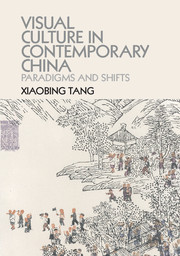Book contents
- Frontmatter
- Contents
- Acknowledgments
- A brief timeline of relevant events
- Introduction Toward a short history of visual culture in contemporary China
- Chapter 1 How was socialist visual culture created?
- Chapter 2 How was socialist visual culture created?
- Chapter 3 What do we see in New China cinema?
- Chapter 4 What does socialist visual experience mean to contemporary art?
- Chapter 5 How (not) to watch a Chinese blockbuster
- Chapter 6 Where to look for art in contemporary China
- Conclusion Seeing China from afar
- Glossary
- List of Illustrations
- Filmography
- Select bibliography
- Index
- References
Chapter 4 - What does socialist visual experience mean to contemporary art?
Published online by Cambridge University Press: 05 January 2015
- Frontmatter
- Contents
- Acknowledgments
- A brief timeline of relevant events
- Introduction Toward a short history of visual culture in contemporary China
- Chapter 1 How was socialist visual culture created?
- Chapter 2 How was socialist visual culture created?
- Chapter 3 What do we see in New China cinema?
- Chapter 4 What does socialist visual experience mean to contemporary art?
- Chapter 5 How (not) to watch a Chinese blockbuster
- Chapter 6 Where to look for art in contemporary China
- Conclusion Seeing China from afar
- Glossary
- List of Illustrations
- Filmography
- Select bibliography
- Index
- References
Summary
An artist may not be able to solve any problems, but it is his basic professional duty to raise questions by means of his art and to endow his work with signs of intellectual reflection.
Wang Guangyi, 1990A central figure in the fast-moving and globally connected story of contemporary art from China, a story often narrated in close parallel to the growing prominence of the Chinese economy since the early 1990s, is no doubt Wang Guangyi (1957–). Best known since the early 1990s for his Great Criticism series, Wang is described in many surveys and art-historical accounts as the defining Political Pop artist, a Chinese Andy Warhol with a poignant political thrust. His bold, poster-like images of Chinese socialist subjects, be they workers or Red Guards, charging at Western consumer brand names such as Coca-Cola and Louis Vuitton, splice together disparate visual icons and logos and often provoke bemused, if also confused, responses.
International excitement over this refreshing turn in Chinese art was first registered by Flash Art: The Leading European Art Magazine, when it featured on the cover of its January/February 1992 issue Great Criticism: Coca Cola, the first mature work in what was to become a seemingly endless series. Almost overnight, Wang Guangyi himself became a hot brand name and a poster-child for the spectacular success of Chinese contemporary art.
- Type
- Chapter
- Information
- Visual Culture in Contemporary ChinaParadigms and Shifts, pp. 140 - 174Publisher: Cambridge University PressPrint publication year: 2015



